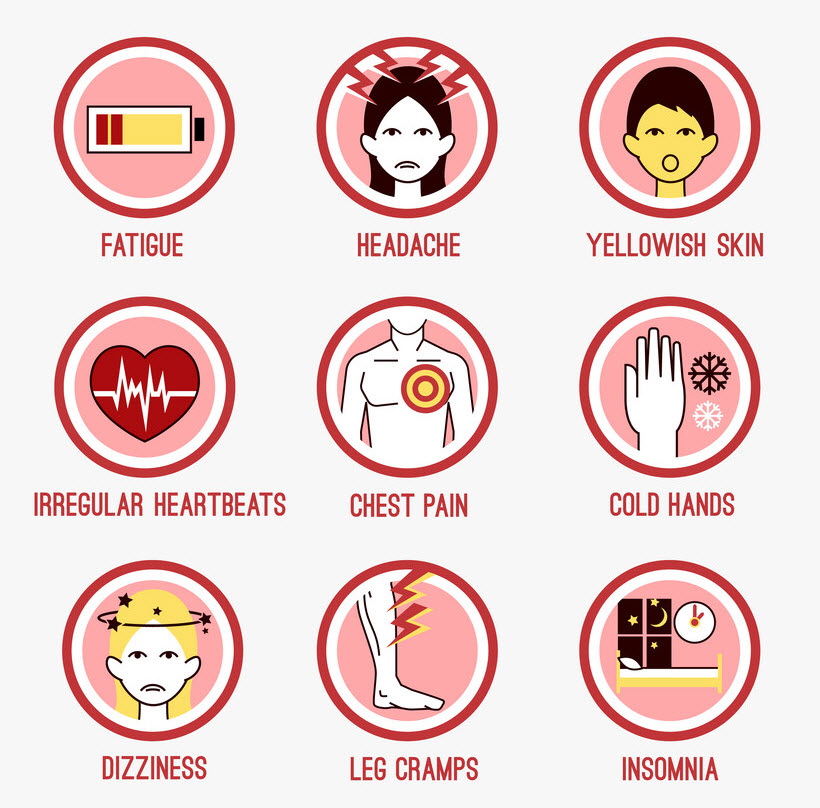This discussion includes the following information related to Anemia:
- Anemia
- Signs and Symptoms of Anemia
- Causes and Types of Anemia
- Risk Factors for Anemia
- Complications of Anemia
- Tests and Diagnosis for Anemia
- Treatment and Drugs for Anemia
Anemia Definition

Anemia is a condition in which you don’t have enough healthy red blood cells to carry adequate oxygen to your tissues. Having anemia may make you feel tired and weak.
There are many forms of anemia, each with its own cause. Loss of blood is the most common cause of anemia. Anemia can be temporary or long term, and it can range from mild to severe.
Treatments for anemia range from taking supplements to undergoing medical procedures. You may be able to prevent some types of anemia by eating a healthy, varied diet.
See your doctor if you suspect you have anemia because anemia can be a sign of serious illnesses.
Signs and Symptoms of Anemia

Anemia symptoms vary depending on the cause of your anemia but may include:
- Fatigue
- Weakness
- Pale skin
- A fast or irregular heartbeat
- Shortness of breath
- Chest pain
- Dizziness
- Cognitive problems
- Cold hands and feet
- Headache
Initially, anemia can be so mild it goes unnoticed. But symptoms increase as anemia worsens.
EMERGENCY CASE Make an appointment with your doctor if you’re feeling fatigued for unexplained reasons. Some anemias, such as iron deficiency anemia or vitamin B-12 deficiency, are common. Fatigue has many causes besides anemia, so don’t assume that if you’re tired you must be anemic. Some people learn that their hemoglobin is low, which indicates anemia, when they go to donate blood. Low hemoglobin may be a temporary problem remedied by eating more iron-rich foods or taking a multivitamin containing iron. It may also be a warning sign of bleeding in your body that may be causing you to be deficient in iron. If you’re told that you can’t donate blood because of low hemoglobin, make an appointment with your doctor.
Causes and Types of Anemia

Anemia occurs when your blood doesn’t have enough red blood cells. This can happen if:
- Your body doesn’t make enough red blood cells
- Bleeding causes you to lose red blood cells more quickly than they can be replaced
- Your body destroys red blood cells
What red blood cells do?
Your body makes three types of blood cells — white blood cells to fight infection, platelets to help your blood clot and red blood cells to carry oxygen throughout your body.
Red blood cells contain hemoglobin — a red, iron-rich protein that gives blood its red color. Hemoglobin enables red blood cells to carry oxygen from your lungs to all parts of your body and to carry carbon dioxide from other parts of the body to your lungs so that it can be exhaled.
Most blood cells, including red blood cells, are produced regularly in your bone marrow — a red, spongy material found within the cavities of many of your large bones. To produce hemoglobin and red blood cells, your body needs iron, vitamin B-12, folate and other nutrients from the foods you eat.
Causes of common types of Anemia
Common types of anemia and their causes include:
- Iron deficiency anemia: Iron deficiency anemia is caused by a shortage of the element iron in your body. Your bone marrow needs iron to make hemoglobin. Without adequate iron, your body can’t produce enough hemoglobin for red blood cells. This type of anemia is often caused by blood loss, such as from heavy menstrual bleeding, an ulcer, cancer, a polyp somewhere in your digestive system, and prolonged use of aspirin or drugs known as nonsteroidal anti-inflammatory drugs (NSAIDs).
- Vitamin deficiency anemias: In addition to iron, your body needs folate and vitamin B-12 to produce sufficient numbers of healthy red blood cells. A diet lacking in these and other key nutrients can cause decreased red blood cell production. Additionally, some people may eat enough B-12, but their bodies aren’t able to process the vitamin. This can lead to vitamin deficiency anemia, also known as pernicious anemia.
- Anemia of chronic disease: Certain chronic diseases — such as cancer, HIV/AIDS, rheumatoid arthritis, Crohn’s disease and other chronic inflammatory diseases — can interfere with the production of red blood cells, resulting in chronic anemia. Kidney failure also can cause anemia.
- Aplastic anemia: This very rare life-threatening anemia is caused by a decrease in the bone marrow’s ability to produce red blood cells. Causes of aplastic anemia include infections, drugs and autoimmune diseases.
- Anemias associated with bone marrow disease: A variety of diseases, such as leukemia, myelodysplasia or myelofibrosis, can cause anemia by affecting blood production in your bone marrow. The effects of these types of cancer and cancer-like disorders vary from a mild alteration in blood production to a complete life-threatening shutdown of the blood-making process. Other cancers of the blood or bone marrow — such as multiple myeloma, myeloproliferative disorders and lymphoma — also can cause anemia.
- Hemolytic anemias: This group of anemias develops when red blood cells are destroyed faster than bone marrow can replace them. Certain blood diseases can cause increased red blood cell destruction. You can inherit a hemolytic anemia, or you can develop it later in life.
- Sickle cell anemia: This inherited and sometimes serious anemia is caused by a defective form of hemoglobin that forces red blood cells to assume an abnormal crescent (sickle) shape. These irregular-shaped red blood cells die prematurely, resulting in a chronic shortage of red blood cells.
- Other anemias: There are several other rarer forms of anemia, such as thalassemia and anemias caused by defective hemoglobin.


